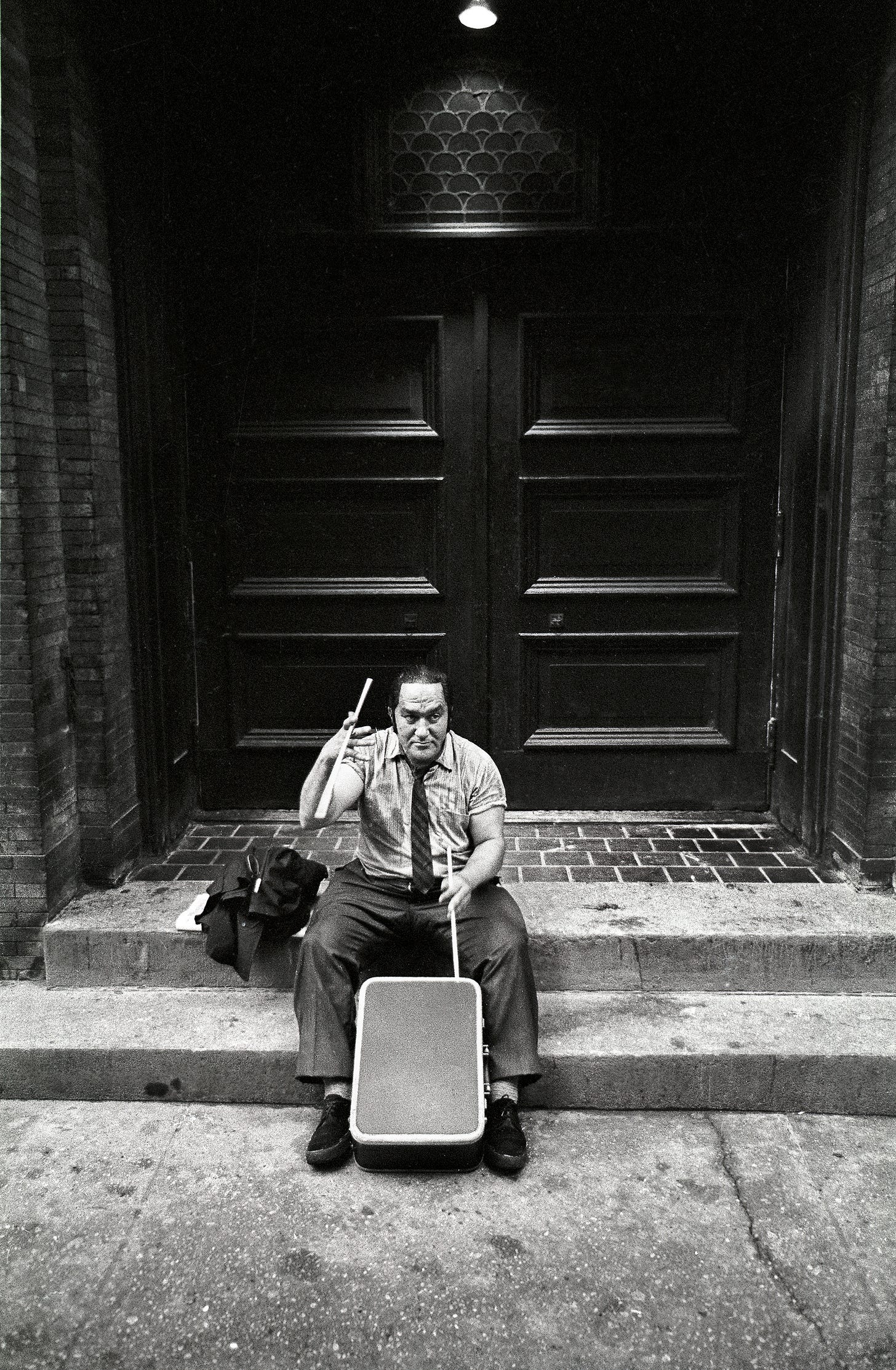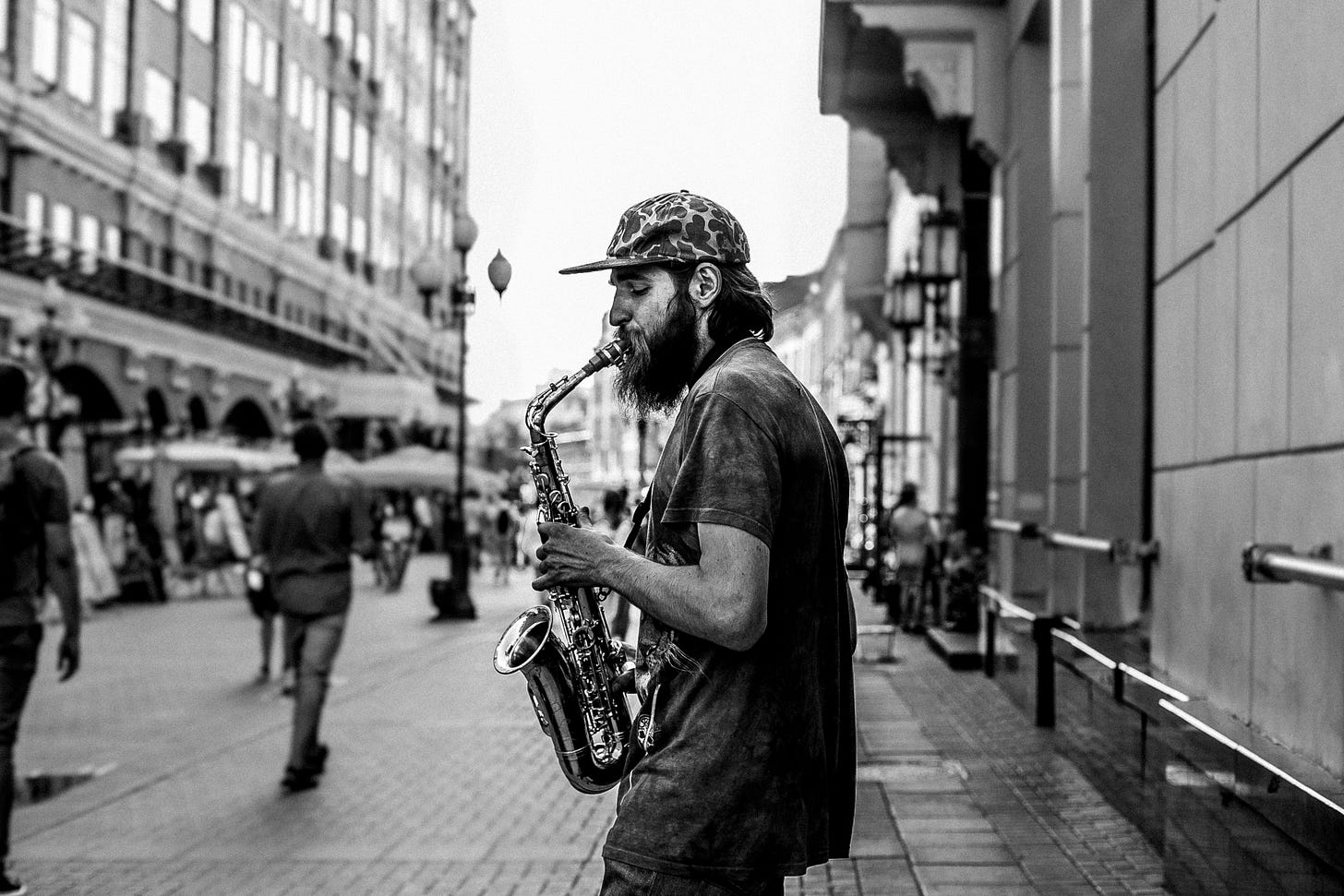I Pay Tribute to Gene Palma and the Forgotten Street Musicians of New York
You can play for huge audiences in the greatest music city in the world, and still disappear without a trace
Street musicians deserve their place in our cultural history, but their songs are rarely preserved. I’m not talking just about recordings, even written documentation is hard to find.
Over the course of many years, I’ve tried to learn the genuine history of street music—and just a few weeks ago I wrote here about the unusual civic responsibilities assigned to these performers during the medieval era. But I couldn’t even have written that short article without sifting through dozens of primary sources from various disciplines—because this subject is almost universally ignored in music history books.
For all sorts of reasons, none of them very persuasive, almost everything about this topic has been kept out of the archives. We know just a few scraps about the music of the city streets, but even those tiny details remind us of how much we’ve lost.
The Honest Broker is a reader-supported guide to music, books, and culture. Both free and paid subscriptions are available. If you want to support my work, the best way is by taking out a paid subscription.
For example, we’re told that Handel admitted to stealing musical ideas from street singers, as did many ‘serious’ composers—Landini, Janequin, and others. But we have little idea what the original versions in the marketplace sounded like. In more recent times, the early history of jazz and blues is closely connected with the music of the streets, but details are elusive and much of what we know based on the thinnest possible documentation.
In my book Work Songs I tried to describe the everyday life of a major US city just a few decades earlier, when street vendors sold items with their own marketing songs—melodic calls describing the virtues of the fruits and vegetables, or pots and pans, or whatever else they offered to customers. But I felt like I had to fight for every scrap of information.
Back in 1938, a researcher for the Federal Writer’s Project claimed that just walking through the streets of Harlem was like hearing a spontaneous concert—all provided by people selling things. The result was, he claimed, “sprightlier music than is heard on the East or West side of the city, for carefree street vendors employ amusing jingles and syncopated rhythms in offering their wares.”
I’d love to share a recording with you. But there is none. There are people alive today who heard that music, but it is lost to us. We know more about opera in the 1600s than about New York street music in the 20th century.
I have a handful of rare recordings of these street cries from other cities, but when I tried to find a single example of an vintage vendor song on YouTube, it took me almost an hour.
But check it out. It’s an extraordinary genre even in this tiny dose—half invocation, half commerce.
I’ve heard amazing street music myself over the years. Sometimes even major jazz figures down on their luck have played for me on a street corner. But even unknown musicians have blown my mind with their pavement performances. I’m not exaggerating when I say these informal jams are sometimes better than what’s playing at Carnegie Hall. You just need to be in the right place at the right time—because there will be no record or concert tour.
On a couple of occasions I have even hired a recording studio and brought street musicians in to do a session. But there’s no guarantee that the recording will match what they did exiled on Main Street. Researchers really ought to go out to the streets and capture these sounds in their natural habitat.
And that happens so rarely.
That’s why I’m happy when someone like street drummer Gene Palma not only gets a dose of respect, but even finds himself in a Hollywood movie. Against the odds, he had his street music honored in his own lifetime, and preserved for the future on film.
I call Gene a drummer, but that’s misleading. It implies that he required drums. But all he really needed were the drumsticks.
And even those were optional. He launched his career beating out the beat on pots and pans, using chopsticks from a Chinese restaurant. Palma did actually play the drums in bands at one point in his life, but his largest audience was busy pedestrians on the streets of New York—where he accompanied their daily routine with happenstance percussion.

He usually brought a snare drum with him, but he was just as happy playing on newspaper racks, vending machines. a garbage can, or anything else that came his way. For Palma, Manhattan was just one big drum, waiting for someone (like him) to unleash its latent rhythmic potential.
You could write a book about the artists who brought their craft to the New York streets in those days. There was Moondog, sometimes called the “Viking of Sixth Avenue.” Or Joe Bush, the last organ grinder in New York. Or Larry Wright, who is probably still out there, playing five gallon plastic buckets as if they were Gretsch’s finest. Or consider the case of Super Bad Brad, who delivers R&B tunes in Greenwich Village, assisted by a boombox and microphone, and once got put on the stage of the Apollo Theater, where he received a thunderous standing ovation—then returned to the streets.
That was Gene Palma’s milieu. It’s a tough audience everyday, and you measure your success one coin at a time.
Palma’s physical appearance was as striking as his music. His slicked down hair looked like the tar they use to pave the Manhattan streets—if anyone had ever squeezed out the oil in Gene’s coiffure, it could have lubed down a turbine engine. His sideburns were ginormous, straight out of an Elvis impersonator’s toolkit. Palma’s clothing was more of the same, evoking a kind of polyester panache, but he must have sweated away many pounds on those hot Manhattan summer days.
Yet Palma’s most endearing quality was the gravitas he brought to the down-and-out settings where he made his music. He could hardly have taken his trade more seriously if he had been teaching students at Juilliard.
And make no mistake, Palma saw himself as a teacher. He didn’t just play the drums, but told you their history—filled with references to Gene Krupa, Buddy Rich, Chick Webb, and others. He knew the greats and their beats, as well as the tricks they played with their sticks. And he wanted you to know about them too.
It was this sidewalk persona that captivated Martin Scorsese, who gave Palma a lasting moment of glory in the film Taxi Driver.
Palma got paid $172.50 for his appearance in Taxi Driver. But in the aftermath he was something of a celebrity—passersby would recognize him from the movie, and toss a few coins or bills his way.
You can also see him in this 1979 documentary on street musicians. His performance at the 35:15 mark deserves (and will reward) your attention—Gene drums and sings and teaches all at once.
But Palma had a life-changing moment while watching the 1937 movie, Hollywood Hotel, which showcased the Benny Goodman band and its star drummer Gene Krupa. “I was 13 years old,” he later recalled. “I jumped up from the seat. Ahhh, that’s what I wanted to be. A drummer.”
Then he had another breakthrough moment, again at a movie theater. In 1959, the Loew’s cinema on 86th on the East Side of Manhattan held a drumming contest to promote a Krupa biopic, which Palma won, That earned him a hundred dollar snare drum and an opportunity to meet Krupa himself. Palma was invited into the legendary Swing Era’s drummers house, and spent four hours that day with his boyhood hero.
Palma now had a drum, a mission, and a role model—and they lasted the rest of his life. When jazz drumming gigs disappeared in the 1970s, he took to the streets, and made money playing for the public.
He kept at it, five days per week, for as long as he could. He stayed indoors only when the weather got so cold he couldn’t perform his spinning drumstick routines. But sometime in the 1990s, Palma disappeared from the streets. He eventually entered an assisted living facility, where he died in 2005 at the age of 81.
Street entertainment hasn’t disappeared from Manhattan. A lot of it is gimmicky, but there are serious musicians out there even today. But the world is less forgiving than it once was. I often hear stories of NY musicians getting harassed by the police—there was a high profile arrest just a few days ago—which is especially sad when you consider that this city’s economy once relied on hundreds of singing street vendors.
There may have been more successful capitalists in New York’s history, but few that spread more pure joy and delight. If you pay attention, rather than just hurry by, there’s still some of that impromptu bliss available for your consumption.
Few of these street performers will get their minute of fame in a hit movie, like Gene Palma. So at least give them a little respect. And share a smile. Maybe some spare change too.




There was a man who sang so beautifully accompanying himself with just a stick string and wash pan (gut bucket?) sounded like Nat king Cole. I think it was 8th st N/R platform- late 90s. He restored my faith in music after being in grad school for musicology - ha.
One of the most memorable artists in NYC during the late 80s-early 90s was the guy with the bent busted up saxophone who would enter a subway car, announce that his spaceship had crashed from Mars and he was in desperate need of Earth dollars to repair his ship - then he would play an example of Martian music - loud screaming and skronking until people gave him money to stop. Don’t know his name but he was legendary